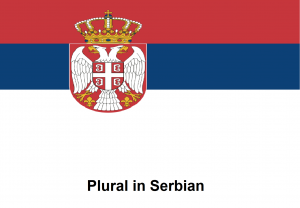Language/Serbian/Grammar/Plural
Hello Everyone, 😊
In today's lesson, we will be delving into the topic of "Plural" in the Serbian language. As you may know, the use of plural forms is essential in many languages, including Serbian, and it's crucial to understand its rules and patterns to communicate effectively. In this lesson, we will explore the basics of forming the plural in Serbian, including the use of different noun endings and declension patterns.
Please feel free to contribute to this page by editing it if you have any suggestions or additional information to share.
We hope you enjoy this lesson and find it helpful in your language learning journey! 😎
After mastering this lesson, you might also be interested in exploring other aspects of Serbian Grammar: Verbs Infinitives, Verbs: Perfective and Imperfective, and Serbian Grammar: Pronouns, possessive pronouns & verbs future to further enhance your understanding of the Serbian language.
Introduction to Serbian plurals[edit | edit source]
In Serbian, the plural form of a noun is generally formed by changing the ending of the word. The rules governing these changes depend on the noun's gender (masculine, feminine, or neuter) and the noun's ending in its singular form.
Plural formation based on gender[edit | edit source]
Masculine nouns[edit | edit source]
Masculine nouns usually end in a consonant. To form the plural, we typically add "-i" or "-ovi/-evi/-ovi" to the singular form, depending on the word.
- Nouns ending in a consonant followed by "-i": pas (dog) -> psi (dogs) grad (city) -> gradovi (cities)
- Nouns ending in a consonant followed by "-ovi/-evi/-ovi": profesor (professor) -> profesori (professors) čovek (man) -> ljudi (people)
Feminine nouns[edit | edit source]
Feminine nouns typically end in "-a" or "-i." To form the plural, we typically replace the "-a" with "-e" and replace the "-i" with "-i."
- Nouns ending in "-a": žena (woman) -> žene (women) knjiga (book) -> knjige (books)
- Nouns ending in "-i": prijateljica (female friend) -> prijateljice (female friends)
Neuter nouns[edit | edit source]
Neuter nouns typically end in "-o" or "-e." To form the plural, we typically replace the "-o" with "-a" and replace the "-e" with "-a."
- Nouns ending in "-o": dete (child) -> deca (children) polje (field) -> polja (fields)
- Nouns ending in "-e": jaje (egg) -> jaja (eggs) pero (feather) -> pera (feathers)
Practice exercises[edit | edit source]
Now, let's practice! Try to form the plurals for the following nouns:
- stolica (chair)
- reč (word)
- brat (brother)
- planina (mountain)
- selo (village)
Plural in Serbian: Summary[edit | edit source]
Words ending with:
- a in plural form changes to e
- e,o in plural form changes to a
- Everything else gets suffix i
- There are possible exceptions from rule above like:
- уво - уши (ear) ;
- око - очи (eye)
Serbian language also have genitive plural, that makes that there are even 2 and in some cases 3 plural forms.
Genitive plural is used in counting, from numbers 2-4 have one form, and starting from 5 have another form.
Some genitive plurals are same as singular, but with different accent.
During counting, with numbers that ends with 1 (exception in 11, 111, 211, 5411...), noun is always in singular form. Other number endings (except for 11-19) apply rule from genitive plural.
Next words: врата (door), маказе (scissor), мердевине(ladder), кола (car) don't have singular form.
Also is in some casses present form of plural that is used to represent group of something: цвет-цветови-цвеће (flower), лист-листови-лишће (leaf).
Examples[edit | edit source]
| Singular | Plural | Gen. plural 2-4 | Gen. plural 5... | Translation |
|---|---|---|---|---|
| јабука | јабуке | јабуке | јабука | apple |
| крушка | крушке | крушке | крушака | pear |
| девојка | девојке | девојке | девојака | girl (adolescent) |
| коњ | коњи | коња | коња | horse |
| зид | зидови | зида | зидова | wall |
| нокат | нокти | нокта | ноктију | finger nail |
| мушкарац | мушкарци | мушкарца | мушкараца | man |
| жена | жене | жене | жена | woman |
| пас | пси | пса | паса | dog |
| уво | уши | ува | ушију | ear |
| рука | руке | руке | руку | arm |
| дан | дани | дана | дана | day |
| оловка | оловке | оловке | оловки | pen |
| дугме | дугмад | дугмета | дугмади | button |
Other Lessons[edit | edit source]
- Nouns
- Adjectives
- Conditional Mood
- Questions
- How to Use Have
- Comaratives and Superlatives
- Be Polite
- Past Participle in Serbian
- How to Use Be

